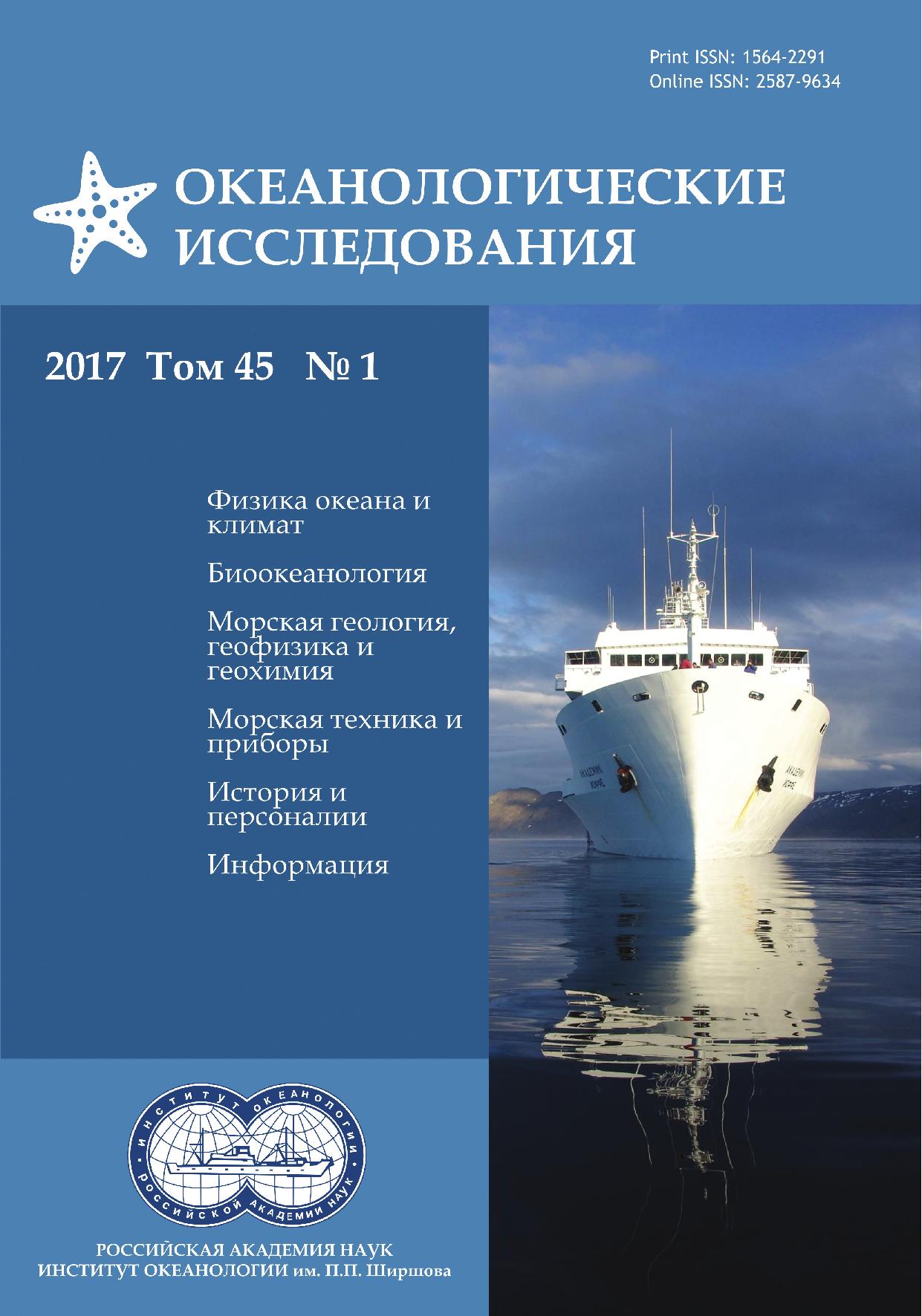Экспериментальные исследования изменчивости термохалинной структуры вод над континентальным склоном северо-западной части Японского моря
Аннотация
В 2015 г. были впервые проведены длительные (в течение полугода) непрерывные измерения термохалинной структуры вод над континентальным склоном северо-западной части Японского моря. Измерения проводились с помощью модуля SBE 52-MP CTD, установленного на автономном профилографе Аквалог на притопленной заякоренной буйковой станции к востоку от залива Петра Великого в теплую часть года с 18 апреля по 15 октября. В статье представлен подход к первичной обработке данных СТД-измерений океанологического профилирующего аппарата, включая специально разработанную программу обработки CTDdata_cor_SBE_52-МР. Данные SBE 52-MP CTD верифицированы с помощью измерений на станциях судового разреза НИС «Академик М.А. Лаврентьев», выполненного 30 мая поперек склона и пересекшего место установки Аквалога. Вертикальные профили температуры и солености по судовым измерениям и данным профилографа Аквалог хорошо согласуются, демонстрируя особенности изменения температуры, солености и вертикальной плотностной стратификации при прохождении мезомасштабного антициклонического вихря, перемещавшегося на юго-запад в области Приморского течения. Верификация измерений модулем SBE 52-MP CTD по данным судовых зондирований SBE-911plus позволила устранить также и систематические компоненты погрешностей. В результате, качественные показатели гидрофизической информации, полученной профилографом Аквалог, удалось привести к стандартам WOCE. Для исследования вихря дополнительно были использованы спутниковые снимки температуры поверхности моря, полученные с помощью радиометра AVHRR ИСЗ NOAA. Пример анализа структуры синоптического вихря показывает перспективность подхода к экспериментальным гидрофизическим исследованиям, сочетающего использование длительных временных рядов наблюдений в толще вод наряду с судовыми разрезами и съемками акватории из космоса с помощью мультиспектральной аппаратуры в целях развития 4-х мерной океанографии.
Литература
- Архипкин В.С., Лазарюк А.Ю., Левашов Д.Е., Рамазин А.Н. Океанология // Инструментальные методы измерения основных параметров морской воды: Учебное пособие. М.: Изд-во МАКС Пресс, 2009. 335 с.
- Гинзбург А.И., Костяной А.Г., Островский А.Г. Поверхностная циркуляция Японского моря (спутниковая информация и данные дрейфующих буев) // Исследование Земли из космоса. 1998. № 1. С. 66–83.
- Жадан П.М., Ващенко М.А., Лобанов В.Б., Котова С.А. Исследование влияния факторов среды на нерест морского ежа Strongylocentrotus intermedius // Вестник ДВО РАН. 2013. № 6. С. 170–179.
- Звалинский В.И., Лобанов В.Б., Захарков С.П., Тищенко П.Я. Хлорофилл, замедленная флуоресценция и первичная продукция в северо-западной части Японского моря осенью 2000 г. // Океанология. 2006. Т. 46. №1. С. 27–37.
- Ладыченко С.Ю. Изменение термической структуры поверхностных вод у побережья Приморья в осенний период 2000 г. // Океанологические исследования: сб. статей по мат. конф. молодых ученых ТОИ ДВО РАН (27–30 ноября 2001 г.). Владивосток: Дальнаука, 2002. C. 75–83.
- Ладыченко С.Ю., Лобанов В.Б. Синоптические вихри в районе залива Петра Великого по спутниковым данным // Исслед. Земли из космоса. 2013. № 4. С. 3-15.
- Лазарюк А.Ю. Динамическая коррекция СTD-данных // Подводные исследования и робототехника. 2009, № 2 (8). С. 59–71.
- Лазарюк А.Ю. Коррекция динамической погрешности данных глубоководных гидрологических наблюдений с помощью CTD-зондов (CTDdata_cor): Свидетельство о государственной регистрации программы для ЭВМ № 2010617298. Правообладатель: ТОИ ДВО РАН. Зарегистрировано в реестре 1 ноября 2010 г.
- Лобанов В.Б., Пономарев В.И., Салюк А.Н., Тищенко П.Я., Тэлли Л.Д. Структура и динамика синоптических вихрей северной части Японского моря // Дальневосточные моря. Т.1. Океанологические исследования. М.: Наука, 2007. С. 450–473.
- Никитин А.А., Юрасов Г.И. Синоптические вихри Японского моря по спутниковым данным // Исследование Земли из космоса. 2008. № 5. С. 2–57.
- Островский А.Г., Зацепин А.Г., Соловьёв В.А., Цибульский А.Л., Швоев Д.А. Автономный мобильный аппаратно-программный комплекс вертикального зондирования морской среды на заякоренной буйковой станции // Океанология. 2013. Т53. № 2. С. 259–268.
- Островский А.Г. Заякоренные мобильные профилирующие аппараты // Освоение глубин океана. Ред. Б.А. Нерсесов. М.: Оружие и технологии. 2017 (в печати).
- Пономарев В.И., Файман П.А., Дубина В.А., Ладыченко С.Ю., Лобанов В.Б. Синоптическая вихревая динамика над северо-западным материковым склоном и шельфом Японского моря (моделирование и результаты дистанционных наблюдений) // Современные проблемы дистанционного зондирования Земли из космоса. 2011. Т.8. № 2. С. 100–104.
- Юрасов Г.И., Ванин Н.С., Никитин А.А. Характеристики фронтов в Японском море по данным судовых и спутниковых измерений // Метеорология и гидрология. 2009. № 4. С. 93–105.
- Юрасов Г.И., Яричин В.Г. Течения Японского моря. Владивосток: ДВО РАН, 1991. 176 с.
- Danchenkov М.А., Lobanov V.B., Riser S.C., K. Kim, M. Takematsu, and J.-H. Yoon A history of physical oceanography research in the Japan/East Sea // Oceanogr. 2006. Vol. 19. N 3. P. 18–31.
- Fofonoff N.P., Millard R.S. Algorithms for computation of fundamental properties of sea water // UNESCO Technical Papers in Marine Science. 1983. Vol. 44. 53 p.
- Operator’s manual. SBE Data Processing 7.23.2. http://www.seabird.com.
- SBE 52-MP Moored Profiler CTD & (optional) Dissolved Oxygen Sensor. http://www.seabird.com.
- Park K.-A., Ullman D.S., Kim K., Chung J.Y., Kim K.-R. Spatial and temporal variability of satellite-observed Subpolar Front in the East /Japan Sea // Deep Sea Research. I. 2007. Vol. 54, No. 4. P. 453–470.
- The acquisition, calibration, and analysis of CTD data. // UNESCO technical papers in marine science. 1988. Vol. 54. 94 р.
Передача авторских прав происходит на основании лицензионного договора между Автором и Федеральным государственным бюджетным учреждением науки Институт океанологии им. П.П. Ширшова Российской академии наук (ИО РАН)












